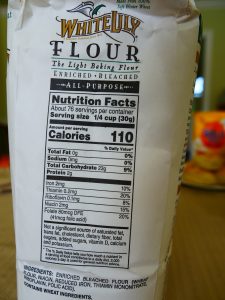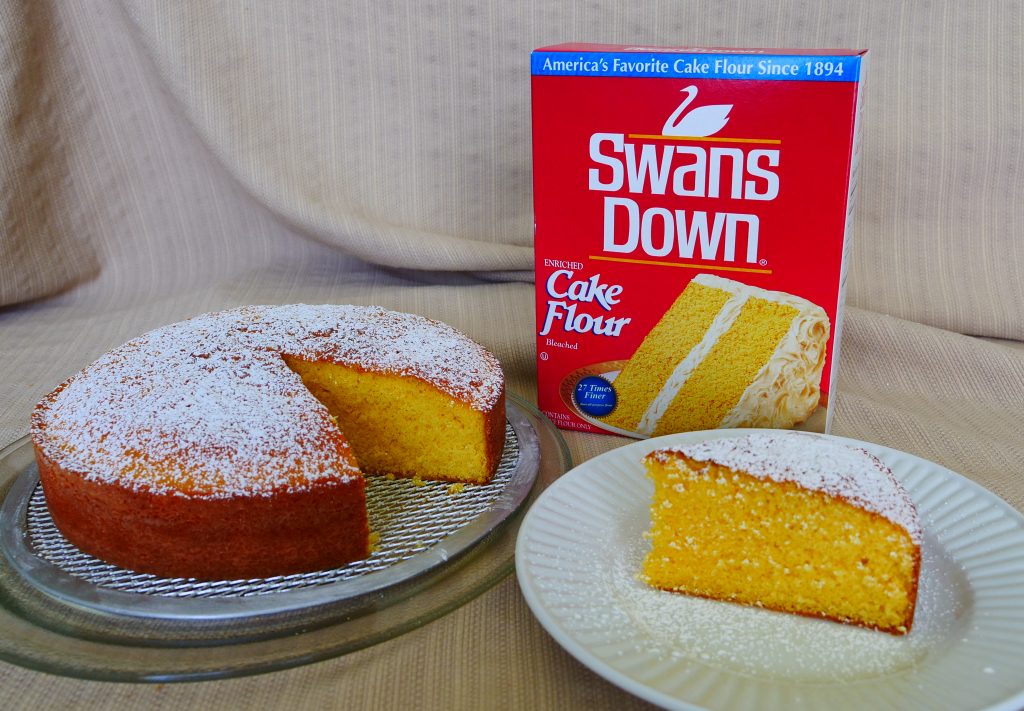Have you ever stood in the baking aisle at the grocery store and wondered why there were so many bags of flour to choose from? Are all the bags pretty much the same, or does it really matter which one you use? I’ll let you in on a little secret all successful bakers know: using the right flour for each recipe DOES make a difference—and learning the basics is super easy with my quick ‘flour power’ tutorial!
Most of the flour we use in traditional baking is wheat flour, made from ground up kernels of wheat. The main part of each grain is the endosperm, the ‘food’ for the baby wheat plant, should the smaller ‘germ’ ever get the chance to germinate. Both the endosperm and germ are covered by a multi-layered seed coat we call the bran, which is usually removed in our every-day flour.
What makes flours different from one another is the variety of wheat used and which parts of the wheat grain are included or excluded in the flour. For this quick tutorial, we won’t get into all the little details, but we’ll focus on what will help you make the right decisions about which flour to use for a particular recipe.
The one factor that will affect your baked goods is the percentage of protein in your flour. And to figure that out, all you have to do is take a quick peek at the nutrition label on the side. The lower the number, the softer the flour and the more tender the end result. The higher the number, the more structure you can achieve. In general, we usually want low-protein flours for tender biscuits and fine cakes, while we want high-protein flours for making yeast breads and pizza crust. I’ll explain the protein content of each flour I discuss so you can understand the difference.
This protein is called gluten and you’d have to be living under a rock on Mars to not have heard all the hubbub about the ills of gluten, along with seeing our grocery store aisles filled with products saying they are gluten free—including things that have never had gluten in them in the first place! I’m not going to enter the gluten debate and I’ll briefly discuss some gluten free flours at the end. If you are avoiding gluten, there are many products out there to make baking GF easier. You might not have bought wheat gluten in little bags to make bread baking even better like I have, but if you do traditional baking, you must have an understanding of the effect the protein (gluten) content will have on your baking.
Our first several flours, the common ‘white’ ones, will not be whole grain and the bran and germ are removed.
All-Purpose Flour
This is the workhorse flour for most of our baking. All-purpose means this flour is good for all purposes, whether you are making chocolate chip cookies or muffins or pancakes. Also called AP for short, this flour comes in bleached or unbleached. In bleached flour, a chemical process causes the flour to be whiter and softens it. I personally prefer to use unbleached AP and avoid the chemical processing. But as far as how it effects the baking, they work much the same. AP flour has 3 grams of protein per serving.
Self-Rising Flour
Self-Rising Flour is all-purpose flour with baking powder and salt added. Many bakers find it convenient to skip the measuring of baking powder and salt and many recipes call for self-rising flour. But control-freak bakers like me don’t use self-rising flour. Why? What if my recipe needs baking soda instead of or in addition to baking powder? What if I don’t need as much salt? What if I need no baking powder at all, say to make a roux for a gravy or because I’m making a yeast dough? I prefer using unbleached AP and adding whatever leavening is best for that recipe. But that’s just me. If you like using self-rising flour, just remember that over time, baking powder will lose some of its rising power. So if you don’t bake often, you might want to buy a fresh bag right before your next baking session. If you’re like me and don’t keep self-rising around, you can add 1 ½ teaspoons of baking powder and ¼ teaspoon of salt per cup of AP to substitute for self-rising.
White Lily All-Purpose (Biscuit Flour or Light Flour)
As Southerners, we prize light, tender biscuits. For years, I’ve turned to the lowest-gluten all-purpose flour I can find: White Lily. This light flour has only 2 grams of protein per serving, one third less gluten than regular AP. I don’t use this flour to make cookies, muffins, brownies, or pancakes. I use it to make biscuits and cinnamon roll biscuits. If I’m out of cake flour (next topic) I’ll substitute this one for it. If you don’t live in the South, I’m sorry to say I don’t know what your options are, but cake flour does not substitute well for it. (That’s according to a friend in California who tried cake flour to make my cinnamon roll biscuits. It was a flop.)
Cake Flour
This very fine flour also has 2 grams of protein per serving and is my workhorse flour when baking most of my layered cakes. (For pound cake I use unbleached AP.) Where I live, you find them in the grocery stores in a box and not a bag, though I buy mine wholesale 25 pounds at a time, because it’s much cheaper that way—not something most home bakers would want to do.
Bread Flour
Now we step out of the light and middle of the road flours and onto harder-wheat variety flours. One quick look at the nutrition label and you’ll see most bread flours have 4 grams of protein per serving. Does that one extra gram make a difference? YES. If you’re making pizza dough, Danish, brioche, French bread, etc., you want a strong, bread flour to help you develop the proper structure. This is why you knead these doughs, to help develop the gluten strands that will create this structure. Gluten is why we have crusty French bread and chewy pizza crusts. Yum!
However, not all bread flours are the same. I won’t say where, but one large bulk supplier sells bread flour with only 3 grams of protein, the same as their all purpose. What’s up with that? On the positive side, I recently found a special bread flour at my local Food City with 5 grams of protein per serving. Yippee!
Pastry Flour
I don’t see this type of flour on my grocery store aisles, but I can buy it at special shops. It has less protein, or gluten, than AP but a little more than cake flour, making it perfect for pie crusts. You can user it for other low-gluten baking, but because it’s not commonly found where I live, I save mine for pie crusts. I did find a whole-wheat version at my local grocery, which was a surprise.
Whole Wheat Flours
These flours use the entire grain—bran, germ, and endosperm—in the final product. This means several things. First is that this flour has more natural nutrition and fiber, as the bran and germ are included. That added fiber means you might need more liquid than you would if using AP, as the bran absorbs more of it. Usually the texture of what you bake is coarser and heavier, though there are ways to minimize that. For instance, some whole wheat yeast breads start with a sponge, or some regular bread flour or AP is added to the whole wheat in the recipe.
Most whole-grain flours have a protein content of 4 grams per serving, giving them the same gluten-punch as bread flours. The addition of the germ means that the shelf life of whole grain flour is not as long as regular white flours.
One whole grain flour I enjoy using is called White Wheat. It’s whole grain, but uses a variety of wheat that isn’t as dark when ground, almost like a cross between regular whole wheat flour and bread flour. I like to add some to my pizza crust , along with my bread flour, for a more flavorful crust.
Other Flours..
Semolina Flour
This is what your pasta is probably made of and you can use it to make your own pasta at home. I like to use it to dust my pizza peel if I’m baking small pizzas on a ceramic stone in my oven, so the uncooked pizzas slide off easier.
Buckwheat Flour
Ever heard of buckwheat pancakes? If not, you might enjoy giving this interesting dark flour a try. It’s not even wheat, but a seed that is naturally gluten free. Which leads us to…
Gluten-Free Flours and Blends
Baking is based on simple chemistry. There are some rules you simply can’t break and expect delicious results. Usually, merely substituting a gluten-free flour in a traditional recipe won’t give you excellent results. Many gluten-free blends combine various flours together, along with binders like xanthan gum, to make baking gluten-free easier. Many of these blends use flours made from rice, brown rice, tapioca, potatoes, etc. Other GF flours that can be used are coconut flour, almond flour, etc.
When I need to do GF baking, I look to America’s Test Kitchens and their “How Can it Be Gluten Free” cookbook series. No paid endorsement here, but I’ve been pleased at the recipes I’ve tried in their pages.
In summary:
Maybe after reading this post, you realize there are some flours out there you’d like to try, or why that certain recipe you tried didn’t turn out as planned, because you were using the wrong flour. If you have any specific questions, send me a comment. If I don’t know the answer, I’ll help you find it—and we can release some flour power, together!












